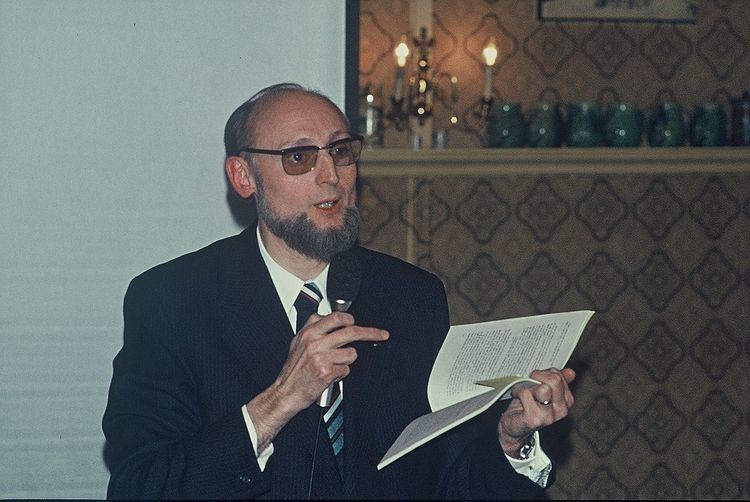Arcaicam Esperantom ("Archaic Esperanto") is a constructed language created to act as a fictional 'Old Esperanto', in the vein of languages such as Old English or the use of Latin citations in modern texts. It was created by Manuel Halvelik as part of a range of stylistic variants including Gavaro (a slang), Popido (a patois) and a scientific vocabulary closer to Greco-Latin roots.
The idea of an "old Esperanto" was proposed by the Hungarian poet Kalman Kalocsay who in 1931 included a translation of the Funeral Sermon and Prayer, the first Hungarian text (12th century), with hypothetic forms as if Esperanto were a Romance language deriving from Vulgar Latin.
c becomes tzĉ becomes chf becomes phĝ becomes ghĥ becomes qhj becomes yĵ becomes jk becomes qu (before e, i) or c (before other letters)ŝ becomes shŭ becomes ù (but see below regarding -aŭ adverbs)v becomes wdiphthongs:
aŭ becomes
aù (but see below regarding
-aŭ adverbs)
eŭ becomes
eùconsonant clusters:
dz becomes
zzks becomes
xkv becomes
cùmi becomes mihivi becomes tu (singular) or wos (plural)li becomes lùiŝi becomes eshiĝi becomes eghisi becomes sihini becomes nosili becomes ilùiThere is a new pronoun egui which is a personal, sex-neutral pronoun. Its intended use is for referring to deities, angels, etc.The infinitive ends in -ir, rather than in the -i of modern Esperanto. Ex.: fari becomes pharir.The verb endings change according to the subject. So it is not necessary to write the subject pronoun, where there is no ambiguity.Ex: The modern Esperanto verb esti (to be), present tense:
mi/vi/li/ŝi/ĝi/ni/ili estasThe Arcaicam Esperantom verb estir (to be), present tense:
(mihi) estams(tu) estas(lùi/eshi/eghi/egui/sihi) estat(nos) estaims(wos) estais(ilùi) estaitThe other verb tenses behave the same way, as does the conditional mood:
The future-tense conjugation estos becomes estoms, etc.The past-tense conjugation estis becomes estims, etc.The conditional-mood conjugation estus becomes estums, etc.The imperative mood behaves differently from that pattern:
The imperative form estu stays estu for singular subjects, but becomes estuy for plural subjects.-o becomes om (sg. noun, nominative)-oj becomes oy (pl. noun, nominative)-on stays -on (sg. noun, accusative)-ojn becomes -oyn (pl. noun, accusative)al x-o, kun x-o becomes x-od (sg. noun, dative – ex.: al domo becomes domod)al x-oj, kun x-oj becomes x-oyd (pl. noun, dative – ex.: al domoj becomes domoyd)de x-o becomes x-es (sg. noun, genitive – ex.: de domo becomes domes)de x-oj becomes x-eys (pl. noun, genitive – ex.: de domoj becomes domeys)-e becomes -œ (adverb) (This is a new phoneme, not present in modern Esperanto. It is pronounced like the German ö.)-aŭ becomes -ez (-aŭ-adverb such as baldaŭ, etc.)-a becomes -am (sg. adjective, nominative)-aj becomes -ay (pl. adjective, nominative)A noun is always written with a capital letter. Ex: Glawom = (la) glavo.The verb infinitive can function as a noun, having the meaning that is carried in modern Esperanto by the root with the suffix -ado. The infinitive functioning as a noun takes, as does any other noun, both a capital letter and a case ending. Ex: Legirom = (la) legado.ki- becomes cuy-ti- becomes ity-i- becomes hey-neni- becomes nemy-ĉi- becomes chey-ali- becomes altri-(Note: Ali-, which in modern Esperanto is not actually a correlative despite its use in that fashion by some, becomes in Arkaika Esperanto as altri- a full-fledged correlative.)
-o becomes -om-a becomes -am-am becomes -ahem-e becomes -œ-om becomes -ohem(-u stays -u)(-el stays -el)the particle ĉi becomes is- (ĉi tiu = isityu)Articles
The definite article la does not exist in Arcaicam Esperantom. If necessary, a specific person or object can be indicated by means of ityu (in modern Esperanto tiu).The indefinite article, which modern Esperanto does not have, does exist in Arcaicam Esperantom. The indefinite article is unu (which is the same word for the number 1).Sed haltu: cuyam Lumom ityun PhenestronTraradiat? Yemen orientom,Ed Yulieta memes Sunom estat!Lewizzu, belam Sunom, ed mortiguEnwian Lunon, cuyu tristœ palat,Char tu, Serwantom eshiam, yamenPlid belam ol eshi memes estas. Ned estu pludEshiam Serwantom, se eshi tuin enwiat:Eshiam westalam Robom werdamEd malsanetzam estat, ed solœ PholuloyWolontœ eghin portait. Eghin phorjetu.Yemen Damom miham; ho, yemen Amom miham!Se solœ ityon eshi stziut!Salutoyn cheyuyd! Cuyel phartais wos? – Hello everyone, how are you?Lùi ex Biawistocom wenat. – He comes from Białystok.Cuyel nomizzas? – What is your name?Nomizzams Petrus – My name is Peter.Ityon comprenams bonœ. – I understand that well.Tempom phughat. – OvidAmom cheyon wencat. – VirgilItyel pasat mondes Glorom. – Thomas à KempisRitmom estat in Tempom cuyom estat Simetrom in Spatzom. – CiceroWenims, widims, wenquims. – Julius Caesar 
